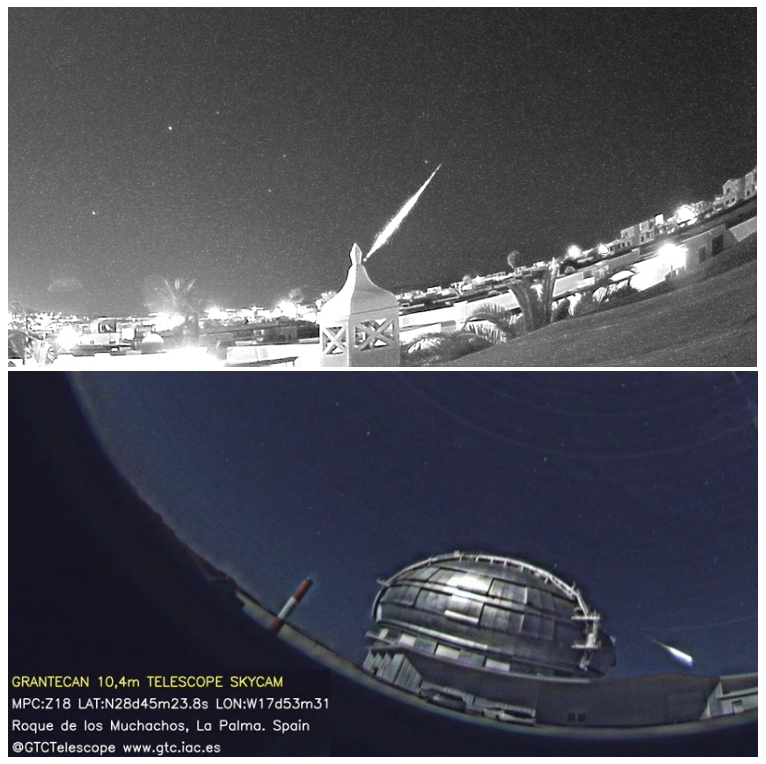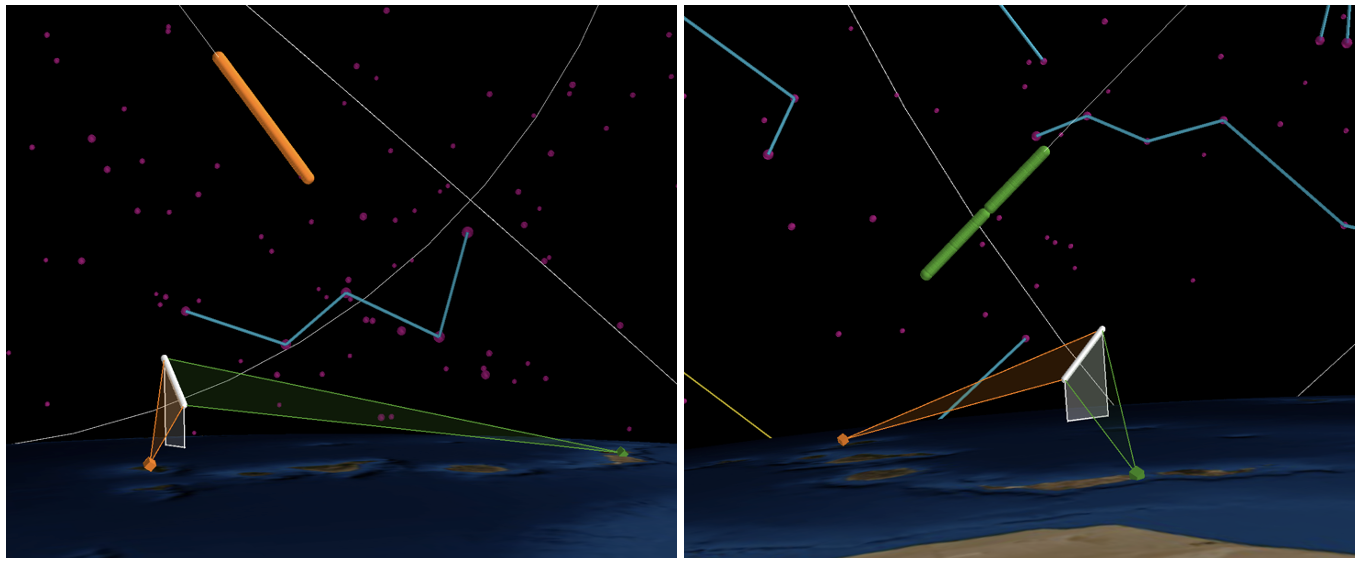First bolide over the Canary Islands with trajectory and orbit reconstructed by a national team
- 1Universitat Autònoma de Barcelona, Spain (eloy.pena@uab.cat)
- 2Universitat Autònoma de Barcelona (UAB), 08193 Cerdanyola del Vallès, Barcelona, Catalonia, Spain
- 3Institut d’Estudis Espacials de Catalunya (IEEC), Gran Capità 2-4, Ed. Nexus, desp. 201, 08034 Barcelona, Catalonia, Spain
- 4Gran Telescopio de Canarias (Grantecan), Instituto de Astrofísica de Canaras (IAC), Observatorio del Roque de los Muchachos, 38679, La Palma, Spain
- 5Observatorio Stargazer LZT, Playa Blanca, 35580, Lanzarote, Spain
- Introduction
The constant influx of new material from space to Earth provides an opportunity to delve into the processes that took place in the formation of the Solar System [1]. Some fragments of asteroids or comets have been wandering through space remaining practically unaltered, ending their journey upon impact with our atmosphere producing the spectacular luminous phenomenon known as a meteor or fireballs [2,3]. These almost meter-sized fragments, also called meteoroids, may be dynamically associated with the decay of comets or asteroid impacts [4]. In addition, their study provides us with valuable information about one of the major potential cosmic sources of near-term danger [5].
In order to achieve this goal, 25 years ago the Spanish Meteor and Fireball Network (SPMN) began monitoring the sky by recording and analyzing large fireballs [6]. Today, the network has 34 stations distributed throughout the Iberian Peninsula, and now also in the Canary Islands. This expansion of stations has resulted in the first detection of a fireball over these islands and analyzed entirely by a national team. Thanks to the new 3D-FireTOC software [7], we have been able to reconstruct the atmospheric trajectory and heliocentric orbit of the bolide SPMN30032021 from CCD video recordings.
- Methodology
To correct for the large distortions produced by fisheye lenses, especially near the edges, we calibrated the cameras with the method proposed by [8], which is a polynomial variant of [9]. Once we obtained the apparent trajectories for each station, we applied the plane intersection method to obtain the atmospheric trajectory [10]. We solve the astrometric system combining the Simplex algorithm [11] and Powell's methods [12]. Finally, projecting this trajectory backwards and correcting for diurnal aberration and zenith attraction, we compute the radiant position and the heliocentric orbit.
For the error calculation we have applied Monte Carlo methods. Using the calibration uncertainties, we generate random variations with a normal distribution for each bolide coordinate. In this way, we used 1000 clones to obtain the average values and the standard deviation of each computed parameter.
- Case Study: Bolide SPMN30032021
On Mars 30, 2021, a bright bolide catalogued as SPMN30032021 event occurred over the Canary Islands (see Table 1). It was an event of considerable importance because it has been the first to be recorded and analyzed by two stations of the SPMN network over the archipelago. One of the cameras is located at sea level, in Playa Blanca, on the island of Lanzarote. The other camera is located at the Roque de los Muchachos observatory, in the GranTeCan facilities, which can be seen in Figure 1.

Fig. 1
The meteoroid began its luminous phase at an altitude of 77.9 ± 0.4 km with a velocity of 14.07 ± 0.15 km/s. It penetrated the atmosphere to a height of 35.3 ± 0.3 km, indicating that it likely did not produce meteorites. The point of maximum brightness reached a magnitude of -11 ± 1, it could have been seen with the naked eye from Morocco. The flight angle with respect to the horizontal was 40.45 ± 0.11 degrees. Due to its low geocentric velocity its atmospheric trajectory was greatly affected by gravitational attraction. Its orbital elements indicate that it originated from the inner asteroid belt. Figure 2 shows the 3D and scaled reconstruction of the SPMN event using the 3D-FireTOC software.

Figure 2. Reconstruction of the atmospheric flight of the SPMN30032021 event with its apparent trajectory as seen from GranTeCan (left) and as seen from Playa Blanca (right).
- Conclusions
The SPMN network continues to expand, providing global coverage throughout the Iberian Peninsula, the Balearic Islands and now also the Canary Islands. We are cooperating with FRIPON and the MOFID networks in the study of common events in France, and Morocco, respectively. In this paper we have presented the first fireball with atmospheric trajectory and heliocentric orbit reconstructed over the Canary Islands, analyzed entirely by a national team. The event SPMN30032021 comes from the asteroid belt and is not associated with any meteor shower, so it is of sporadic origin.
With our activities we expect to continue increasing the number of meteorites recovered with reliable orbits and increase our understanding of the origin of meter-sized meteoroids disrupting into the Earth’s atmosphere [7]. By increasing the number of meteorite-dropping bolides we expect to gain insight on the physical processes that might produce the detachment of these rocks in near-Earth space [13].
Acknowledgements
This research has been funded by the research project PGC2018-097374-B-I00, (MCI-AEI-FEDER, UE). EPA and AR have received funding from the European Research Council (ERC) No. 865657.
References
[1] Murad, E., & Williams, I. P. (2002) CUP. UK, 234 pp
[2] Ceplecha, Z., Borovička, J., Elford, W. G., ReVelle, D. O., Hawkes, R. L., Porubčan, V., & Šimek, M. (1998) 84(3), 327-471
[3] Trigo-Rodríguez J.M. (2019) Colonna G., Capitelli M. and Laricchiuta A. (eds.), IOP, pp. 4-1/4-23.
[4] Jenniskens, P. (1998). Planets and Space, 50, pp. 555.
[5] Moreno-Ibáñez, M., Gritsevich, M., Trigo-Rodríguez, J.M., and Silber, E.A. (2020) MNRAS 494, 316–324.
[6] Trigo-Rodríguez J.M. et al. (2006) Astronomy & Geophysics 47, 6.26
[7] Peña-Asensio, E., Trigo-Rodríguez, J. M., Gritsevich, M., & Rimola, A. (2021) MNRAS 504(4), 4829-4840.
[8] Bannister, S. M., Boucheron, L. E., & Voelz, D. G. (2013) ASP125(931), 1108.
[9] Borovička, J. (1992) AICAS, 79.
[10] Ceplecha, Z. (1987) BAIC, 38, 222-234.
[11] Motzkin, T. S. (1956) In SAM, 6,109-125.
[12] Powell, M. J. (1964) TCJ, 7(2), 155-162.
[13] Trigo-Rodríguez J.M. et al. (2007) MNRAS 382, 1933-1939.
How to cite: Peña-Asensio, E., Trigo-Rodríguez, J. M., Rimola, A., Núñez, A., and López, R.: First bolide over the Canary Islands with trajectory and orbit reconstructed by a national team, European Planetary Science Congress 2021, online, 13–24 Sep 2021, EPSC2021-752, https://doi.org/10.5194/epsc2021-752, 2021.

